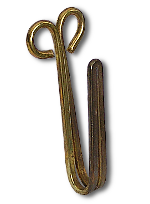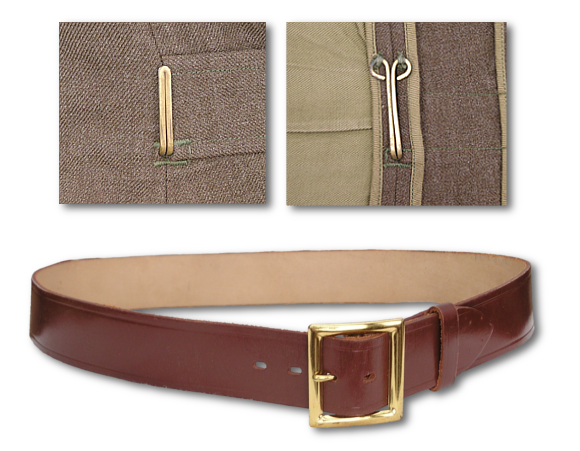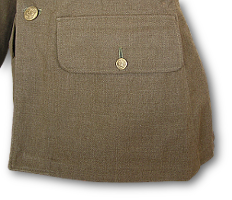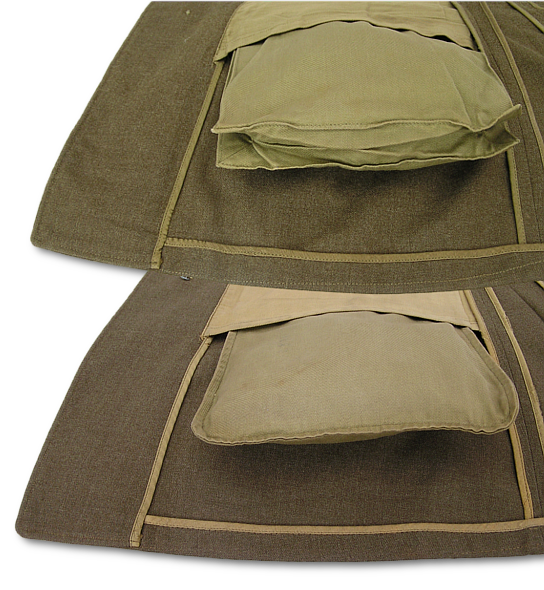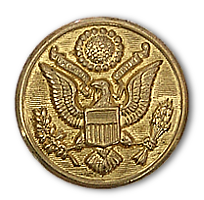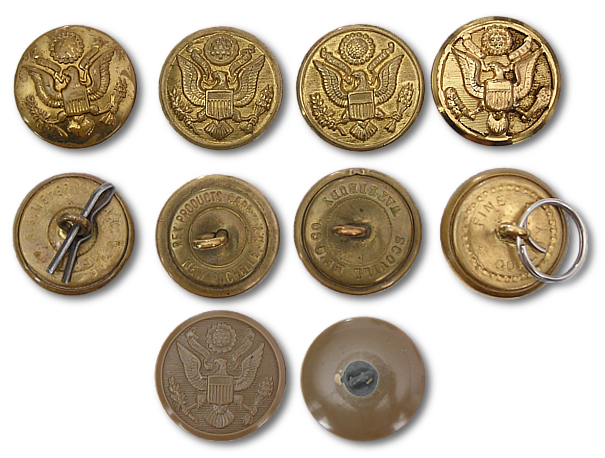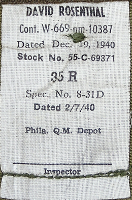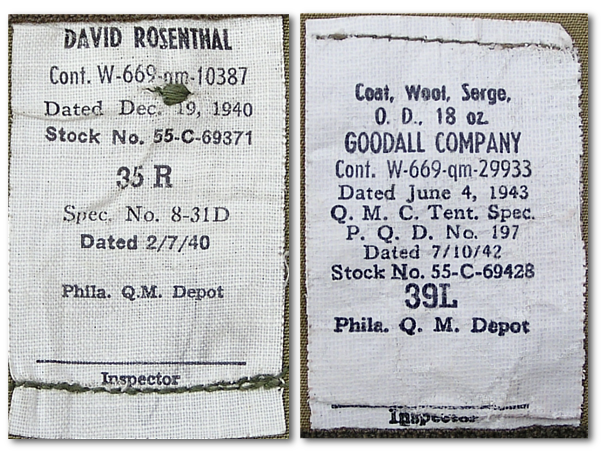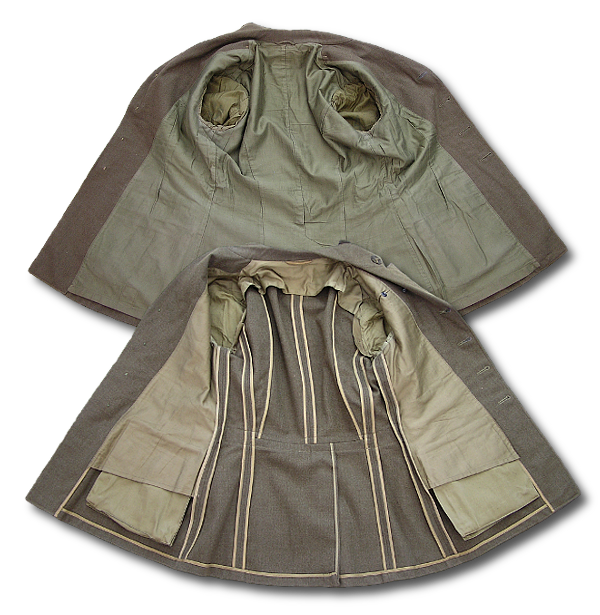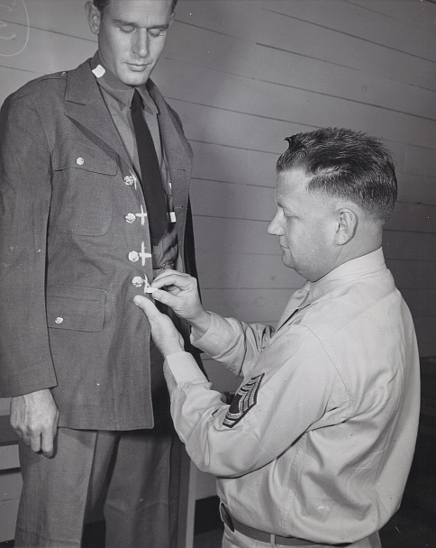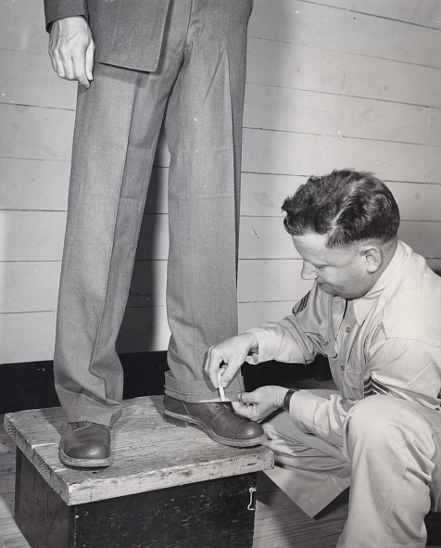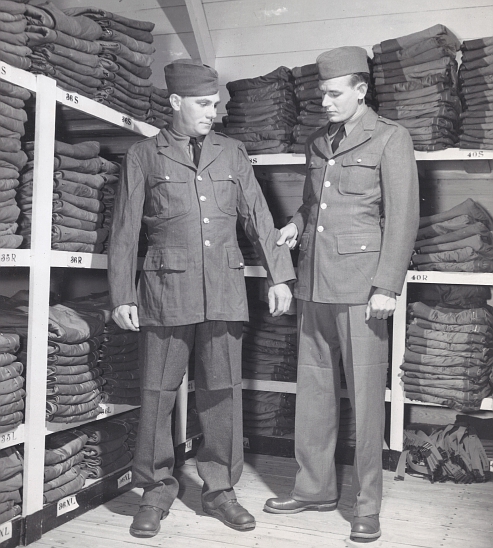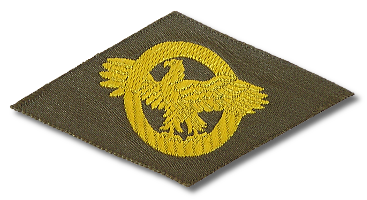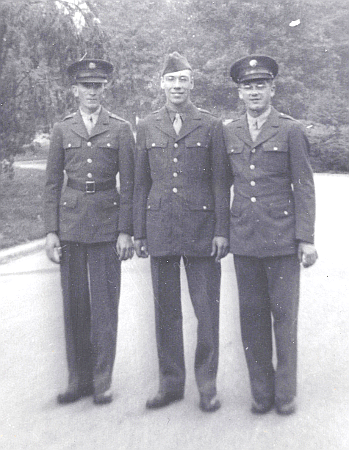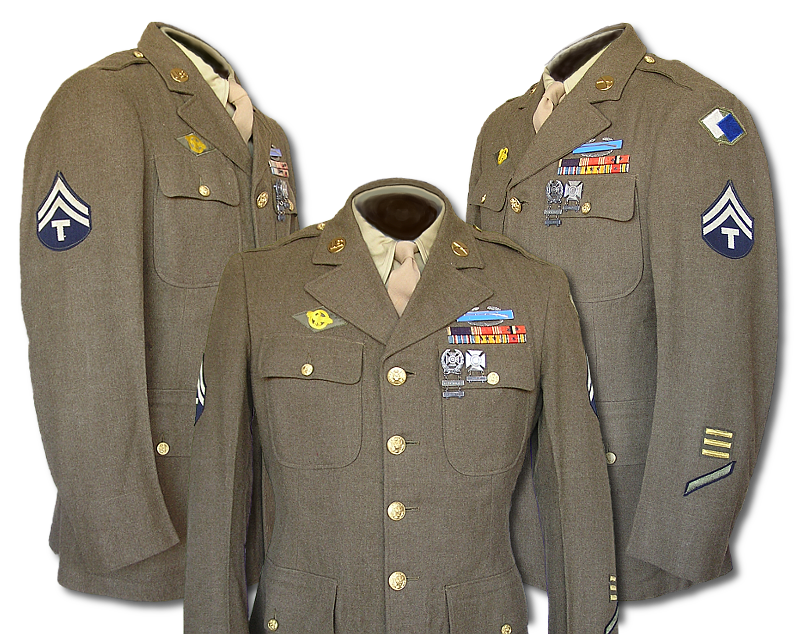U.S. Army Enlisted Men's Coats
18 Ounce Olive Drab Serge Wool Coat

Specification QMC 8-31D Dated 7 February 1940
Stock No. 55-C-69299 - 55-C-69510
M-1942 18 Ounce Olive Drab Serge Wool Coat

Specification PQD 197 Dated 10 July 1942
Stock No. 55-C-69299 - 55-C-69510
One service coat was provided to Army and Army Air Force enlisted personnel as a mandatory allowance at induction centers regardless of climate. The service coat was declared "limited standard" in September, 1944 after which it was, more or less, limited to issue in the zone of interior until stocks ran dry. The service coat did remain an authorized substitute for the new Olive Drab Wool Field Jacket where stocks of the new jacket were insufficient. When soldiers were issued the new OD wool field jacket, the service coat was to be turned in. Enlisted men were allowed to keep their service coat at separation upon receiving an honorable discharge.
| Key Visual ID | Primary Materials | Fasteners | Color | Labeling |
QMC 8-31D:
| Body: 18 ounce serge wool. Lining: Cotton Twill. | The coat had 10 buttons total. Front Closure: Four 36 ligne (9/10 inch) gilt buttons. Pockets: One 25 ligne (5/8 inch) gilt button per each of four pockets. Shoulder Loops: One 25 ligne (5/8 inch) gilt button per each of two loops. | Olive Drab Shade 33. | A Contractor label was sewn to the inside of the right, lower pocket. The size tariff was ink stamped on the lining just below the collar. |
| Treatments | Approx. Contract Run | Preceded By | Replaced By | Companion Garments |
| N/A. | QMC 8-31D: 7 June 1940 to 16 July 1942. PQD 197: 10 November 1942 to 5 June 1943. | QMC 8-31D: Enlisted Man's Service Coat, Specification QMC 8-31C, dated 11 September 1937. PQD 197: Enlisted Man's Service Coat, Specification QMC 8-31D, dated 7 February 1940. | Olive Drab Wool Field Jacket, specification PQD 437, dated 12 May 1944. |
|

Above, left to right: Shown are the progression of changes that occurred to the back of the enlisted man's service coat between 1926 and the end of its production in 1943. During this time there was little discernible change to the front of the coat, however material conservation pressures and the changing role of the coat produced easily recognizable differences in the back. First, a coat from 1938 shows the plain back with tapered waist and hooks for the leather garrison belt; second, the completely redesigned coat of 1940 for improved field use with bi-swing back, sewn in cloth half-belt, hooks for garrison belt, and longer rear vent; third, belt hooks were removed as the garrison belt was dropped from official issue to conserve leather; fourth, the bi-swing back was dropped in 1942 to conserve wool as the coat was relegated to a dress only role.
(touch or point mouse at picture for expanded view)
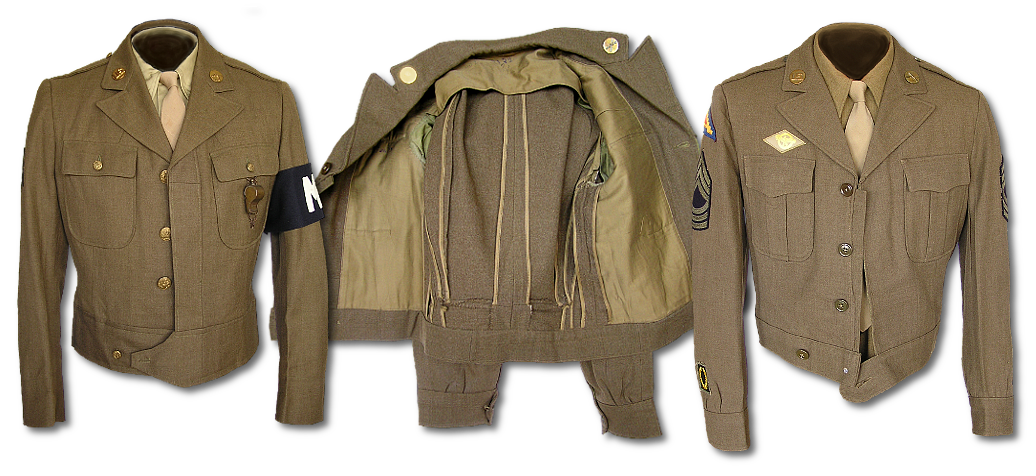
Above, left to right: Shown are two examples of the wool service coat tailored to resemble the Olive Drab Wool Field Jacket. This practice became fairly common after the wool field jacket became standard issue in the fall of 1944. Some examples were expertly done (far right) and bear a strong resemble to the newer jacket, while others retained many of the service coats original features (coat on left). Regardless of the external appearances, a cut down service coat can nearly always be identified by its partial lining (center); a feature unique to the service coat of 1940-43.
|
The enlisted man's service coat of WW2 was a garment caught between opposing philosophies and changing times. Ultimately, unable to adequately perform in the field in a time of war, its production was halted before the end of the war, and was replaced by a more versatile garment. Pre-war developments had transformed the service coat into a close-fitting, dress item with business suit-like styling. This was so much the case that when war broke out in 1939, in a preparatory move, the garment was redesigned to improve its functional qualities in the field. In the meantime, the thinking that led to the economical, dual purpose dress/field garment was shifting toward the development of specialized field garments designed with a high level of military efficiency. In 1941 a true field jacket was developed and by 1942 was being issued in quantity. These developments caused the service coat to be relegated to a dress only item. No longer used in the field and with the need to conserve wool a pressing consideration, the service coat was again revised to better suit its new role. If things had ended there, the service coat may have continued on and filled a useful role as a dress garment. But, it didn't. The development and issue of the Olive Drab Wool Field Jacket, which was also to double as a dress garment, caused procurement of the service coat to end in 1943. The continued failure by Quartermaster Corps to totally separate dress items from field items would eventually bring an end to the wool field jacket as well. In fact, it wouldn't be until the post war era that a totally separate enlisted man's dress uniform would become a reality. The wool service coat was a component of the enlisted man's winter service uniform, which also included a wool cap, wool overcoat, wool shirt and tie, wool trousers, and leather shoes. Service uniforms were the most fundamental uniforms issued and consisted of two essential types; the winter service uniform (wool) for cooler weather and the summer service uniform (cotton) for warm weather. In posts, camps, and stations, the winter uniform was prescribed for habitual wear when the weather did not require use of the summer uniform. Early on, service uniforms were dual purpose and were also worn for combat and simulated combat. Additionally, they were prescribed for wear on many other occasions including furlough, leave, pass, parade, inspection, etc. Regulations required that the winter service coat be completely buttoned when worn, and when not equipped for combat it was to be worn with a shirt and tie. Service uniforms were composed of traditional styling, color schemes, materials, and button designs unique unto each service that made it easy for anyone to distinguish Soldier from Sailor from Marine. Furthermore, during the WW2 era these same basic elements were also used to differentiate between Officers from Enlisted Men within each service. The WW2 Army enlisted man's service coat was no exception; its material, color, and style were distinctive and easy to recognize. The winter service coat of WW2 was a fitted design that relied upon a multi-piece back, front vertical darts, and a rear cloth half belt to provide its form. A roll collar was used with a wide notched lapel. The shoulders had button down loops on top and were supported by internal padding. The front closure was secured with four buttons with the top one located high on the chest creating a high gorge and the lowest one closing at the waist line. The skirt hung to just below crotch level and there was a generous rear vent extending from the belt to the bottom. There were two patch chest pockets and two internally hung lower pockets, each of which was closed with a button down flap. Exterior fabric was olive drab colored 18 ounce wool serge. The lining was cotton twill and covered only the back yoke area, sleeves, and two-thirds of the upper front sections. Under the lining there was a support strap on each side of the coat attached to the underarm seam and to the top of the lower pocket. After WWI the enlisted man's blue dress uniform was eliminated in favor of a dual purpose, olive drab uniform that was to be worn in the field and for dress. This decision set up a long running situation where two design elements diametrically opposed to one another would clash as the enlisted mans service uniform continued to evolve: One demanded military utility essential for an effective field garment, and the other required style and fitting appropriate for a dress garment. The fundamental appearance of the service coat changed dramatically in 1926 when the lapel collar was adopted. This limited the coat's protective qualities and necessitated the use of a tie. By the outbreak of war in Europe in 1939, further refinements in fabric and fit resulted in a coat that, despite its olive drab color, had been transformed into what amounted to a fairly tight fitting dress garment. Shortly after the outbreak of war in Europe, several changes were proposed to improve the utility of the enlisted man's service coat in the field. Test samples were made up and examined, and approval was given in November, 1939 for a new design that allowed for a greater range of motion during physical activity and increased pocket capacity. Specifications for the new coat were drawn up by the Quartermaster Corps on 7 February 1940 and designated 8-31D. To keep a smart appearance yet allow greater movement, the back of the coat was reworked by adding pleats to the shoulder area. This allowed the garment to expand across the back and shoulders when the arms were raised or extended. The expandable back was a popular feature used in commercial sports coats at the time and was commonly referred to as a bi-swing or action back. Movement was also enhanced by lengthening the vent slit in the back of the coat, which made bending and squatting easier. Finally, the carrying capacity of the coat was increased by changing the lower, internally hung pockets to a bellows type. Because all of the revisions occurred in the back or were internal, when the coat was viewed from the front there was no discernible difference between the old and new designs.
To allow expansion of the pleated back and pockets, the full lining used inside the old design had to be totally reworked. The entire back section of the lining was removed leaving in its place just a small rear yoke. The lining in the two front halves of the coat now came to an end at about the middle of the lower pockets. With the full lining of the old design gone, a variety of low necked sweaters could be worn underneath the coat for added warmth.
In order to maintain a fitted form, an integral belt one and a half inches wide of matching material was added to the back of the coat. As it turned out, snugness in the waist area often caused the coat it to ride up when the arms were raised creating a bubbling effect in the pleated back that remained present even when the arms were lowered. This effect, essentially spoiling the coat's appearance, was the result of incompatible design objectives clashing in the finished garment. When production began in the spring of 1940, the brass belt hooks used to support the enlisted man's leather belt, a feature carried over from the previous model, were still incorporated in the coat. With the introduction of the cloth half-belt, the leather belt and hook arrangement was deemed redundant. Nevertheless, the new coat continued to be issued with the belt hooks until the spring of 1941. At this time pressure to conserve leather finally caught up with the coat and authorization was given to drop the hooks as the leather belt was no longer to be issued. The story of the leather belt didn't end there, however. As a popular item, enlisted men continued to purchase their own belts at post exchanges and retail outlets and wear them throughout the war years. It is not uncommon at all to see period photos showing the belt being worn well after its 1941 termination date. Around the time the belt hooks were eliminated discussion first emerged concerning the deletion of the bi-swing back. This was prompted by the introduction of the Olive Drab Field Jacket, which by this time was in full production and was in the process of supplanting the service coat for campaigning in the field. Though no changes were made to the coat at the time, pressure to conserve critical materials and mounting evidence of its uselessness as a field garment kept it in discussions for revision and even elimination. Early in 1942 the need to conserve wool and brass again put the service coat under scrutiny. At this time it was agreed to make changes to the enlisted man's overcoat that would reduce its virgin wool content and substitute plastic buttons for the metal type then in use. These same options were also open for discussion concerning the service coat. But, any reduction of wool quality in the service coat was ultimately rejected due to the already unusual lightness of the existing garment. Discussion surrounding the use of plastic buttons took longer to settle due to the perceived affect that changing them would have on morale. It wasn't until the end of that summer that approval was ultimately given to include plastic buttons as a substitute standard item for the service coat. Plastic buttons as it turned out saw little use on the service coat as is evidenced by the very few surviving examples that exhibit them. After the issues surrounding the wool content and buttons were settled, the Philadelphia Quartermaster Depot rekindled discussion of eliminating the bi-swing back by citing the opportunity to save substantial amounts of wool by doing so. Even though the service coat was being phased out as a field garment and its tendency to ride up around the waist causing an unsightly bubbling in the back was well known, it was ultimately pressure to conserve wool that provided the impetus for change. So, it was in June, 1942 that approval was given to the Philadelphia Depot to go ahead with their recommendation to remove the bi-swing back. At this same time the elimination of the bellows feature in the lower pockets was also approved. The Philadelphia Depot drew up tentative specification number 197 on 10 July 1942 for the new "18 ounce Olive Drab Serge Wool Coat". Sometimes the nomenclature also included an "M-1942" qualifier in its description. While specifications for the new coat were being finalized, the last major procurement under the old specification 8-31D was initiated. Coats procured in July, 1942 under the 8-31D technical specification, as well as many other earlier dated contracts that had not yet been executed, were produced using the new pattern in order to maximize savings in wool material. It is for this reason that service coats contracted during July,1942 and others, some of which had been contracted as early as the beginning of 1942, exhibit contract labels printed with the 8-31D specification yet were made with the plain back and simplified pockets of the latter 197 specification. In effect procurement of the new coat began in July, 1942 due to the immediate substitution of the new pattern for the old during this time. It wasn't until procurement began again in November of 1942 that contract labels showing the 197 specification appeared. The redesigned coat of 1942 retained the same back as the design of 1940 except that the pleat was removed and the seam sewn shut. The lower pocket reverted to the pre-war seamed, turned, and stitched construction. It is interesting to note too that with the return of a plain back, the partial lining was retained. This was most likely done to minimize impact on the production process and to help conserve cotton material. In the fall of 1942, as procurement of the revised specification was to get under way, there was discussion about eliminating the service coat altogether. Though for morale reasons it was decided to retain the coat, this would only be a temporary delay in its eventual demise. With the issues surrounding the service coat settled for the time being, it would now be how the shortcomings of the olive drab field jacket were addressed that would eventually determine the fate of the service coat. The final chapter in the service coat's war-time history would not be written before it underwent one final change. In the spring of 1943 the pattern was altered to provide a looser fit in the shoulders and arm openings. This action was taken after complaints arose over ill-fitting coats that were too tight in the shoulders and had sleeves too short and sleeve openings too tight. These changes are unconfirmed in surviving examples because of the difficulty in detecting them visually, but it is assumed that they were put into effect prior to the coat's final production run that occurred in June, 1943. As soon as the service coat was deployed in theater of operations, the ETO command determined it was inadequate for the cold, damp conditions encountered there. Additionally, it was determined that the field jacket, though a better option, was neither robust nor warm enough either. There were two schools of thought that clashed in response to the need for improved cold weather field clothing; first was the position taken by the ETO command, which wanted a short, wool jacket along the lines of the British battle dress outfit that could be used for both field and dress wear; second was the position taken by the Quartermaster Corps, which was invested in the development of a universal combat uniform built upon a system of layered clothing designed expressly for field use. With the failure of the olive drab field jacket, the ETO command was reluctant to wait for the QMC to develop an improved version. Feeling that a warmer jacket was urgently needed, the ETO command took independent action in 1942 by authorizing the theater's Chief Quartermaster to design and procure a short wool field jacket for issue there. Two different types of jackets were eventually produced; the first one had characteristics of both the British jacket and the American field jacket, and a second one that more resembled the British style. Both were manufactured in quantity by England's clothing industry. Later, in 1943 the Army Air Force followed suit with its own particular example that could be worn alternatively for combat flying missions or dress purposes. Already heavily invested in the wool field jacket concept, the ETO command continued to press the Quartermaster General to develop a standardized version of the garment for general issue. Persistence paid off and in September 1943, the QMC, with its work on a universal cold climate combat uniform completed and procurement in full throttle, reluctantly agreed to develop a short wool field jacket. The new jacket was completed in the spring of 1944 and was called the Olive Drab Wool Field Jacket (specification 437, dated 12 May 1944). Designed primarily as a field garment, the new jacket had a number of attributes in this regard that made it far superior to the service coat. This, coupled with the fact that the new jacket was also designated to be used as a dress garment, sealed the fate of the service coat. With the introduction of the new dual purpose wool field jacket, the service coat became a redundant item in a war-time military where there was no room for waste. Therefore, in the fall of 1944, after production of the new jacket had been ramped up sufficiently to meet demand, the service coat was declared "limited standard". This meant that the service coat would no longer be procured, but it would continue to be issued until its stocks were exhausted. In November, 1944 the wool field jacket was classified as standard issue. For some time, while industry was retooling for the production of the new jacket, the Army adopted the policy of reserving its issue for overseas troops who needed it the most, while issue of the service coat continued in the zone of interior. In retrospect the decision to develop the wool field jacket at all could be viewed as surprising. At the time it wasn't needed in the scheme of the QMC's newly completed field uniform, nor was it needed as a dress garment because the wool service coat occupied that role. And issuing the wool field jacket as a dual purpose garment was especially curious in the light of the problematic design conflicts the service coat had recently been through. Predictably, the wool jacket ended up suffering from being forced to play the same two incompatible roles as the service coat had. Just in reverse order; the service coat was a tight fitting dress garment that tried to add features to make it a better field garment, and the wool field jacket was a loose fitting field garment that ended up being issued in sizes too small or tailored down to make it a better fitting dress garment. Being forced to fill the conflicting roles of dress and field garment would ultimately doom the new wool field jacket as well.
The service coat was issued to Army and Army Air Force enlisted men at the time of their induction. One coat was issued per man as part of a mandatory clothing and equipment allowance and as such was free of charge. Since the coat was part of the basic service uniform it was issued without regard to climate zone. Enlisted men were expected to keep the coat clean and take care of any minor repairs that needed to be done during their time in service.
The service coat was a fitted garment designed to give a neat appearance. To achieve the Army's prescribed look with a minimal amount of tailoring, the coat was produced in a wide range of chest sizes that progressed incrementally from 32 to 50, and in a number of lengths including regular, long, short, extra-long, and stubby. If a coat needed to be tailored to achieve a proper fit, it was done on site at the reception center. Extremely large, small, or otherwise odd sizes were sometimes ordered directly from the Philadelphia Quartermaster Depot where they were made up according to specific requests. At the time of separation, enlisted men were permitted to keep what amounted to one complete winter service uniform and one complete summer uniform. Army regulations stipulated that in order to retain these items individuals had to be placed on inactive duty status or receive an honorable discharge. In the case of an honorable discharge, shirts, overcoats, and coats were designated to have an honorable discharge emblem affixed to them. |
This emblem, popularly known as the "ruptured duck", was a small lozenge patch done in gold on either an olive drab or khaki background that depicted an eagle with wings spread standing amid a ring displaying thirteen stripes. It was sewn or sometimes even glued on the right breast or just above the right breast pocket of designated garments. The main purpose of the emblem was to show the person was discharged from service and had served their country honestly and faithfully.
Just as the service coat changed in appearance during the war years, so did the service uniform as a whole. Changes to uniform components, usually for conservation purposes or to improve appearance, resulted in an admix of old and new articles circulating at same time. Added to this was the fact that at the beginning of the war the service uniform was used in both field and dress roles. And as a result, the winter service uniform of the WW2 years appeared in a number of different configurations often intermixed at the same moment in time. In the early war years when the service uniform was worn in garrison it consisted of a coat with a leather belt, a peaked cap, wool shirt and trousers in contrasting "light shade", a black tie, and russet brown shoes. When used in the field, the cap was replaced by a felt campaign hat or steel helmet, the leather belt by web gear, and the trousers were tucked into canvas leggings.
In early 1941, the leather belt and peaked cap were dropped for conservation reasons. The peaked cap was then replaced with a small, foldable, envelope type cap known as a garrison cap. Though the peaked cap and leather belt were no longer Government Issue items and not part of the service uniform's official repertoire, many soldiers liked these items and continued to privately purchase and wear them throughout the war years.
Early in 1942 the black necktie was supplanted by a new khaki colored version. The new necktie was washable, made of conservation friendly materials, and provided added contrast to the olive drab uniform. Shortly thereafter, a lighter weight cotton khaki shirt was introduced and became an increasingly popular alternative to the flannel shirt for wear with the winter service uniform. The use of the khaki shirt provided a cooler alternative and, like the necktie, provided additional color contrast. The enlisted man's wool trousers had gone through steady refinement since the war began and by early 1944 were transformed into a garment designed primarily for field use. One change involved darkening the trousers from the traditional early-war "light shade", which provided color contrast to the darker service coat, to the darker olive drab shade 33, which matched the new wool field jacket. As the new darker trousers were issued some inevitably found their way into the wardrobes of men who had been issued the older service coat, and when worn together they provided yet another look to the service uniform. It is important to identify how and when uniforms changed because these occurrences serve as markers that provide valuable historical reference points. For example, a photo showing the peaked cap, leather belt, and black tie worn together can, with reasonable certainty, be dated to 1941 or earlier; or a photo showing a soldier wearing the khaki necktie would indicate the spring of 1942 or later; or finally, dark wool trousers would likely indicate 1944 or later. Insignia was an important part of the service uniform and served to communicate essential information about the person, such as their rank, specialty branch of service, service history, and other special training and accomplishments. Service coats were one of the principle garments on which various types of insignia were worn. There were explicit regulations governing how, when, and where insignia was to be worn on the uniform. These regulations served to keep the uniform organized and looking at its best. Some types of insignia were a required part of the uniform, some optional, and some were to be worn when prescribed by the commanding officer for certain events or occasions.
Insignia can be found adorning on much of the upper portion of the service coat including the collar and lapels, above the upper pockets and on the flaps, and on the length of both sleeves from the shoulder to just above the cuffs. The most common types of insignia were either sewn on in the form of unit, rank, and specialty patches or pinned on in the form of medals, ribbons, badges, and crests. Some uniforms are seen with only the required minimum insignia present, while others are seen replete with insignia. It was common for veterans to remove all or some of the insignia from their uniforms after the war. This was done for any number of reasons, but some common ones include to apply insignia to veterans' association uniforms, or simply to make displaying them easier and more convenient.
Some of the most common insignia found on the enlisted man's winter service uniform are highlighted below:
Each button on the enlisted man's service coat was made in gilt metal and displayed the United States Coat of Arms on its front. The coat of arms was done in high relief for officer's buttons and in low relief for enlisted men's buttons. The service coat used 36 ligneLigne - A term meaning lines that refers to a method of measuring buttons by which a number of lines is used to indicate the size of the button. There were 40 lines to an inch. (9/10 inch) buttons for the front closure and 25 ligne (5/8 inch) buttons for the pockets and shoulder loops. From time to time officer's buttons can be found attached to enlisted men's uniforms, but were usually put there in error in an effort to replace original buttons that had been damaged. During the WW2 era, many service coats had their buttons damaged from bad dry cleaning practices. Pressing machines routinely crushed button stems, and sometimes even the button face, making buttoning the coat awkward if not difficult. To avoid this situation, many coats had their buttons attached by cotter pins or rings rather than thread so that they could be removed before the cleaning process. The wool field jacket, introduced as a replacement to the service coat in 1944, proved to be quite popluar among soldiers. It took some time to ramp up production of the new jacket to the point it became available to everyone. In the meantime, the jacket was reserved for overseas troops leaving those without it anxious to sport its new style. Many soldiers, however, took matters into their own hands and had their service coats altered into the new "Ike" design. Tailoring the service coat into an "Ike" became a fairly common practice and was initiated and paid for by individual soldiers. Quality and workmanship varied considerably among these conversions. Some coats had an outward appearance almost undetectable from the Government Issue field jacket pattern, while others were best described as vague representations of it. The new "Ike" style was such the rage, in fact, that in addition to the service coat many other types of garments, some far less appropriate, were converted into the new style. Some of these types included M-1943 field jackets, herringbone twill jackets, and even shirts! See the "Details III" section above for images of these conversions. It is unknown whether a general order was issued that permitted the service coat to be converted into the "Ike". It should be noted here that both officers and enlisted men had their coats cut down. What is certain, though, is that some conversions were dubious in appearance and quality, and would not have conformed to uniform regulations or specifications describing the wool field jacket. The fact that these conversions were permitted to exist at all is interesting in light of the fact that in December, 1944 the QMC undertook a program that sought to test the feasibility of converting surplus service coats into field jackets. The program was dropped in August, 1945 after test samples were found to be unsatisfactory because they were only able to provide the functionality of a dress garment. Test samples could not be made roomy enough to allow proper freedom of movement nor provide the space needed underneath for additional garments required for proper cold weather field use. Nevertheless, many examples of service coats cut down by officers and enlisted men survive today, which bears testament to the popularity of a practice which played an interesting role in the histories of both the service coat and wool field jacket. Even though the service coat was produced in numerous sizes, it is not at all uncommon to come across examples that needed further altering to fit an individual. The coat was designed for easy altering and had five vertical seams that ran down the back of the coat; one in the center of the back, one from the top of each shoulder down to the bottom of the coat, and one from under each armpit down to the bottom of the coat. Any combination of these seams could be used to alter the coat's stated size. Furthermore, the row of closure buttons was often moved in either direction to adjust size. If acquiring a service coat for reenacting or for a display piece, it is especially important to check the seams and button positioning for alterations before purchase to ensure a proper a fit. Service coats and other woolen garments from the WW2 era have been stored away for many decades and over that time many have been subjected to pest damage at some point. Often referred to "moth damage", this appears as a series of small holes or surface tracks in the material. Damage can be localized or spread throughout the garment and is the result of poor storage practices. Woolen garments like the service coat are highly susceptible to pest damage. Pests that can damage or destroy woolen garments are numerous in type and do not just include moths. In the era of wool and silk garments, clothes moths once were the scourge of closets and wardrobes and still do exist. However, they are far less common today in the era of synthetic fabrics. In fact, many other types of more common insect pests destroy natural fiber garments. Some of these pests include roaches, silverfish, and carpet beetles. Additionally, vermin such as mice are also attracted to and chew on natural fibers as well. Dirty garments are more attractive to vermin. Fabric contaminated with sweat, body oils, and food stains draw vermin in because these substances provide the extra sustenance they need for a successful existence. For those who plan to collect or keep garments from the WW2 era, diligent care should be taken to keep them clean and away from areas where any potential pests may reside. It is very common to see WW2 era uniforms with insignia applied out of regulation. The frequency of this phenomenon can only be explained by the sheer numbers that were in uniform and the difficulty involved in keeping everyone informed of the numerous regulations that existed. Some mistakes were barely noticeable and common, while others were more bizarre. Examples range from applying the rank insignia intended for the cotton uniform on the wool uniform, to wearing service ribbons out of order, to even finding insignia sewn in place incorrectly oriented. Some bi-swing back service coats can be found with one or more elastic bands fitted horizontally across the inside of the back. The ends of the bands were attached to the shoulder pleat seams on each side of the coat in an effort to cure the bubbling effect that occurred in the back when the arms were raised and the coat rode up around the waist. Once the arms were lowered the elastic band would pull the expanded pleats back into place leaving the back lying flat. Service coats have among the highest survivability rate of any US made garment from the WW2 era. This is due to the fact that as part of the basic service uniform the coat was issued to every soldier during induction and it was among the few items they were officially allowed to keep at separation. At separation centers service coats came out of overseas bags to have all of the insignia that the soldier earned during his time in service affixed to them. The coat with its insignia telling the story of the soldier's service was proudly worn home. As the years passed these uniforms were preserved by veterans and their families as the main keepsake of the soldier's participation in the war. |
